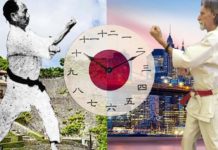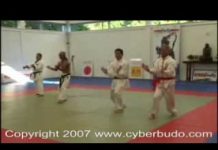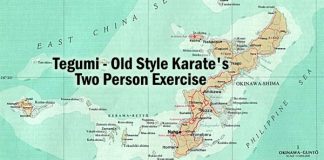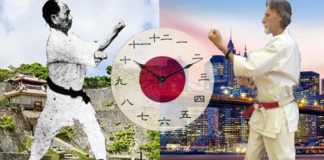Kata? Not in this dojo. We only do fight’n Judo here. It’s bad enough you have to learn some of it just before ya wanna pass your Dan exam; but after that . . . forget it!
The intent and meaning of these and similar opinions about kata have rung out in scores of dojos throughout the country. Unfortunately, it has been relatively easy for a novice judoka to overhear such opinions; and it is still easier for the novice to condition his training by the blind acceptance of such poor advice.
All of us, without exception, have at one time or another harbored such misconceptions about kata. This is due principally to two reasons. First. it is a natural consequence of our lack of familiarity with the intended wholeness of Judo. This natural consequence, in itself, cannot be condemned; but as a prevailing attitude, it becomes an evil which adversely affects the maturation of training applications, is generally unavailable. It is only through correct Judo education that one may come to understand and appreciate the importance of kata and apply it intelligently to his training and secure its benefits.
Unfortunately, this article cannot give you specific technical advice or discussions about kata because of the space limitations. Such information, correctly written, would require a comprehensive book. It may be more important and appropriate to simply convince you of the importance of kata. This article, therefore, will deal with a “sales talk” about kata, with the hope that it will provoke and “awaken” you to discover the technical truth about it and bring new, vital life to your training.
If it can accomplish this, you will reap many benefits. What is referred to as kata applies in principle to all kata. But for the purpose of this article, the interpretation of kata especially refers to the nage and katame no kata.
Since you are expecting a “sales talk,” it may be best to start with something practical. Just who in the Judo world uses kata? Speaking on a top-level international basis, you should first know that there aren’t any champions who cannot perform kata; all champions perform it well. While kata alone has not made them champions, the very fact that they can do it expertly means that somewhere along their long their hard training road they have employed it in their training. Their expertise with kata did not come by a process of osmosis.
In terms with which you at least are geographically familiar, few of you will disagree that the competitive style and effect of, say, James Bregman (Shufu) is currently (1964) the most dynamic and the best in the USA. Bregmans judo history and contest record date back many years; but he may be best known to you as the 1964 National AAU Middleweight champion, the 1964 Olympiad Middleweight 3rd place winner, the 1965 Maccabiah Games Middleweight champion. Having had a large share in Bregman’s early years of Judo training, personally designing and directing all of his training schedules during those formative years, I can assure you that he literally “grew up” on large doses of throwing and grappling kata, the nage and katame no kata respectively.
Another national case in point lies with the current (1965) National AAU Grand Champion, Hayward Nishioka (Nanka), who also exhibits a tremendously effective and stylish Judo, which is outstanding among American Judoka. Nishioka’s skill with kata is also remarkable; and, together with Bregman, they were chosen by the All-Japan Judo Federation to perform nage no kata at the 1962 All-Japan National Judo Championships – the second foreigners accorded this honor. Their splendid performance is well remembered in Japan.
Past champions in our national Judo scene include Ben Campbell (Hokka) (and a future United States Senator from Colorado) and further back, John Osako (Chicago/Konan). Campbell will be remembered for National AAU weight titles and Pan American titles, and John Osako for AAU Grand Championships and two Pan American Grand Championships. Both of these competitors possess excellent skills with kata.
Currently abroad starting with World and Olympic champion Anton Geesink of the Netherlands down through such famous champions as Japans winning Olympic trio of Isao Inokuma, I. Okano, and Nakatani, as well as Japan’s three time all-Japan A Kaminaga and the currently reigning All-Japan titlist S. Sakaguchi, Canada’s Douglas Rodgers, and A. Kiknadze of the USSR all are, without exception, kata experts. As a side note of interest, All-Japan championships on a truly national basis began in 1948; all winners two of whom have been world champions were and are kata experts.
European past international “greats” who were and still are masters with kata including France’s B. Pariset and H. Courtine; Belgium’s H. Outlet; and Great Britain’s C. Palmer, G. Gleeson, and G. Keer. So much for who does kata in expert fashion; let’s see what kata is.
Finding out what kata really is, its purposes, and how to employ it in training is not as easy as you might imagine. But one fact is sure: merely turning to the average daily Judo scene for this information will not produce the answer. Kata as practiced today (perhaps with rare exception) is not the kata intended by the founder, Jigoro Kano, and is not giving optimum benefit to Judoist who perform it. Just why this is a fact requires some discussion.
In my own experience, as I saw more and more kata, I knew that something was amiss; just what that “something” was, however, eluded me. All I could see and what you too will see if you take time to look around was a meaningless, arid “dance of shadows” in each kata performance. Largely, kata was an exhibition; there was no modern-day training application for it. I became suspicious and immensely intrigued; for, knowing full well the practical and efficient mind of Jigoro Kano, the designer of Kodokan kata, I knew that he would not give kata such weak intention. Kata for him must have had an efficient function and a definite role to play for judoka.
I begin with a comprehensive survey of all Judo books published. Every major work on kata ever published, including those in Japanese language, was included. They brought absolutely little or no help for, at best, they are all incomplete, being filled with technical gaps that leave major issues unanswered. The only exception, in my opinion, was found in the two fine works of T. P. Leggett, The Demonstration of Throws and the Demonstration of Holds, and one Japanese classic. While giving thorough technical details, they however lacked the practical application of kata to training.
Still perplexed, I fell upon the idea of interviewing the oldest and most experienced sensei I could find in Japan. Surely, if this information was unrecorded, it must be in the minds of the oldsters. I was only partially right in this thought. In the interviews, all sensei spoke of modern-day kata as being far off the track. They pointed out technical discrepancies on the current mat-scene, which convinced me more than ever that the real truth about kata was not getting out to the modern Judoka, not even from those who knew. The reasons for this apparent laxness will not be discussed in this article. It is sufficient for our purpose to know that it is fact.
In one of my interviews I had the good fortune to meet with the former secretary of Jigoro Kano, who told me that I would find interesting and complete information on kata among the founders personal technical notes and diaries. These sources, plus the classic work on kata written by Yamashita and Nagaoka (now out of print) and edited by Jigoro Kano himself, were filled with the original concepts of kata. Since he was in possession of these documents, he offered to let me peruse them. I jumped at the chance and found exactly what I had been looking for all these many years. I want now to pass on to you some of the information that I discovered, limiting it for the sake of brevity to discussions other than pertinent to specific techniques.
First of all, the great fighting systems of Japan, the bugei, were made effective and were actually constructed from kata. Whether systems of “empty-handed” fighting like jujutsu, bladed-weapon systems like kendo (formerly kenjutsu), or stick systems such as embodied in jodo (formerly jojutsu), all of them became “fighting” systems because of kata. Under no circumstances did these great systems get strong simply by having various combatants getting in and “mixing” it up. It was a normal process of “walking before running” in which efficient movement and technique was first designed, developed, tested, improved, and finally standardized through the media of kata. Kata always preceded randori and the true combative test, the shinken shobu. Kano, in his synthesis of Kodokan Judo from jujutsu and other combative systems, recognized this necessity and did not build his famous Judo system on free “hammer-and-tongs” type of training.
In practical terms, translated for your training, this means that unless you have technique built and working for you, you cannot hope to compete effectively in sporting contests because you will not have the proper skills. “You too must learn to walk before you run.” The difference between great champion Judoka and those who just putter around and never make it is largely due to the amount of time spent in developing tools to work with technique and a strong body. There is no better was of achieving this than by a balanced use of kata study as a regular supplement to training. Each technique of kata has a basic principle with, if understood and mastered in kata, can easily be applied to variations, which will broaden and strengthen Judo performance in general.
It is also significant that you know that Jigoro Kano thought highly of nage no kata and katame no kata and referred to them under the combined title of randori no kata. His insistence on this term should tell you immediately that they are inseparably linked to randori. The founder thought of these two kata as the basic foundations to every Judoka’s skill. Kata provides fundamental building blocks by which a Judoka might develop his technique as broadly as possible. He expected all Judoka to make a regular study of kata.
Still another important issue about kata is that the founder did not want kata to be purely a ceremony. In all of his technical notes, the underlying idea is “take the ceremony out of kata.” What this implies is that, while kata is an excellent manner by which to display or exhibit Judo, this should not become the fundamental purpose of kata. Kata properly applied belongs in the training of all Judoka; kata is a training method, a “tool,” if you will. By the founder’s thought, full Judo maturity cannot be achieved without substantial doses of kata applied throughout the Judo life of each Judoka.
Kata is an intrinsic training method of Kodokan Judo, and it has two distinct developmental stages. The first of these is the “doing” stage – a time when we must study and practice it so that we can gain a mechanical understanding of it. It is a time when we are concerned with each and every technical detail. At this stage, kata is of little training value as a completed training tool; we are simply shaping this tool for later use. After we have a rather good technical basis for kata and can give a rather polished performance of it, then we can put it to use and find answers to technical problems about the various techniques it embodies. This is what can be referred to as the “using” stage. Then and only then will kata become truly useful. Each judoka differs in his learning ability, and it is difficult to generalize about when to begin kata study and when to expect a Judoka can attain the “using” stage. Though kata can be begun at almost any level of Judo experience, it is perhaps best started at the SanKyu level; and with constant study and practice, allowing two or three years in which to complete the “doing” stage, a judoka can, after that, put it to optimum use.
Inherent in each technique of kata are “lessons” essential to an under standing of that technique, basic and variation factors, which enhance the polished performance of the technique for randori and shiai. In direct practical terms for training, this means that kata can teach the reasons why a technique will succeed or fail in randori or shiai application. However, in order to be able to find those “lessons” in the kata, the Judoka must have developed his kata out of the “doing” stage into the “using” stage.
That kata is a prearranged exercise is perhaps the source of the biggest misunderstanding. To most Judoka, and many inexperienced instructors, this “cooperation” has come to mean that tori is always a “winner,” and uke is going down to a well-deserved defeat. It also comes to mean that uke, in his cooperation, must “jump” for tori, trying his best to make the whole performance look good. Nothing could be more erroneous or injurious to the use of kata as a training tool. To see this, let us turn back to the two developmental levels of kata, the “doing” and “using” stages discussed earlier.
Kata performed as an exhibition or demonstration is largely a “doing” type of kata. By the nature of demonstration, kata used in this fashion always sees tori emerge victorious to graphically show technical aspects about Judo in informing or entertaining an audience. Ukes cooperation here, however, must not be one of “jump” for tori, in spite of the predetermined condition of “losing” to tori. Kata, as a demonstration, is but a shallow and limited usage of kata; it is not the primary purpose of kata, though most tendencies in modern Judo restrict it to this role. But, even here, if correctly performed as the founder intended, it is a beneficial performance.
Kata, performed as a “using” type of exercise, will see the failure of many attempts by tori to apply his technique, tori will not always “win.”
This is as it should be, if kata is being used correctly. The kata is thus an evaluative device, which registers incorrectly, applied technique and can reveal the reasons why tori is failing to produce the correct result. In nage no kata, uke makes only predetermined efforts to foil tori, and tori beforehand realizes these actions are to come. In spite of this knowledge, should the technique not come off well, it is a definite sign that tori is not applying his technique properly. How can he fail with a cooperative uke and expect to “defeat” a non-cooperative uke in randori or shiai? In katame no kata, after certain preliminaries, uke is free to actively, and in an undetermined way, extract himself from toris technique. Uke’s escape actions are not prearranged except of utilizing legitimate Judo methods. If, with this “perfect” chance to immobilize uke, tori fails, how can he ever hope to immobilize a uke who from the beginning, is struggling to defeat him.
Cooperation in kata is only a limited one which requires uke to be in a certain position at a certain time so that tori can apply the required technique. This arbitrary preparation does not include the “jumping” of uke or feeble attempts to grapple with tori. In nage no kata, uke is thrown down and thrown hard! In katame no kata, uke is held, choked, or arm-locked effectively, or uke is at liberty to escape. This is the founder’s intended “use” of kata; nothing less then an interpretation has optimum value.
When speaking of the prearranged nature of kata, I found something in Jigoro Kano’s technical notes which was a “bombshell” to me – at least until I thought it out. I pass it on to you. How many times have you heard a judoka say, “kata”. nah. Never use it for training. I’m a believer in uchikomi as the best way to learn a technique”? Here is the “bombshell”: In the founder’s mind, uchikomi is kata. Think about it. In uchikomi we have nothing more than a prearranged method of working with our uke. We repeat certain actions against his more-or-less cooperative self. We both know what is going to happen.
I am rapidly exceeding the space allotted to me, and so I cannot give you much more data; but I do want to leave you with two more important aspects about kata. The first of these is that from the outset, as you study and practice kata, you must have a thorough understanding of the basic roles of tori and the uke from the standpoint of who is attacking. On the surface, this sounds like a silly statement; since the essence of the kata is here, let us take only as brief general look at it.
Generally, it can be seen that uke attacks tori and by skillful, correct maneuvering, tori manages to overcome uke. This is not always the case! In nage no kata, there are certain techniques where uke only wishes to attack; he “thinks” about attacking and has the attack initiative stolen from him by tori. Still another; uke attacks, loses the attack initiative, regains it, and loses it finally. The technical explanation here is involved and is related to what is known as different stages of sen or “initiative”; we cannot delve into this here. I merely wish to alert you to the fact that, unless you know each and every technique, you cannot hope to perform the kata correctly. Only competent instruction can guide you here; seek it out.
Finally, many Judoka complain that kata is subject to instructor interpretations. “How can I do kata when one teacher says one thing and another says something else?” The question is pertinent and so important that I want to squeeze it in here. Kodokan kata is standardized. There is a technically “right” way (only one); but you must bear in mind that, by natural evolution, Kodokan kata has changed over the years. From the founder’s time there have been modifications – even the actual changing of techniques. In 1960, the Kodokan sought and got the agreement of all master Judoka in Japan, formulating a standard method of kata. Therefore, Judo instructors who are not up to date on this standardization may be using older concepts no longer in vogue. Other variations in teaching are usually the result of personalized versions or lack of knowledge about kata. This, the selection of a qualified up-to-date kata instructor is vital to your getting the truth about kata for your training.
Along these lines, you should also know that Kodokan kata, while standardized, is not the only Judo kata in existence. There have been various attempts by high-ranking Judo instructors from Japan to establish private kata or interpretations of Kodokan kata. The matter becomes not so much a matter of which kata are “right” and which are “wrong” as understanding that this divergence exists. But the thing you can be sure of is that a standardized Kodokan kata exists; and if you are interested in it (and you should be), you will perhaps have to search it out from quite a variety of kata styles.
Kata is vital to Judo maturation – both as a system, and to you as an individual Judoka. It must be emphasized as a training method, not a demonstration. The truth about kata is not currently being placed before the Judoka of the world, and they have every right to label what they now see being passed off as kata, as something weak and almost useless. They are right about the interpretation being placed on kata today, but they are not right about true kata. It is the case of the singer, not the song.
By Donn Draeger – This article was first published in the 1966 AAU/JBBF Offiial Judo Handbook.
Edited By Dennis Helm






